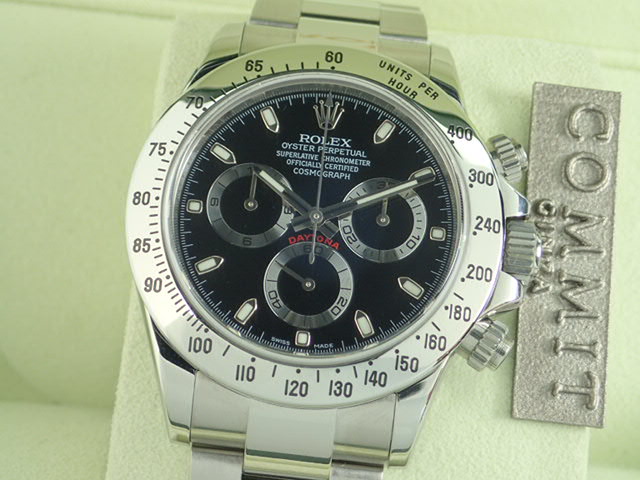Hello!
This is Kaneko from Commit Ginza.

When it comes to assets, where do watches stand?
As I mentioned in my blog yesterday , in terms of relative value, it is in a position to be recognized as an asset in any country around the world, like the US dollar, art, fine art, gold bullion, etc.
Art, fine art, gold bullion, platinum, and gasoline are also valued in US dollars.
To put it simply, if a Daytona with the reference number 116520 is worth $20,000, it is a US dollar asset.
It is no exaggeration to say that it is like holding $20,000 in US dollars or having a US dollar fixed deposit .

Of course, if the yen appreciates, the value converted into Japanese yen in Japan will decrease, and if the yen depreciates, the opposite is true.
I think you should not worry about that and just think about the amount in US dollars.
If 1 dollar is 110 yen, it would be 2.2 million yen, and if it is 100 yen, it would be 2 million yen.
It's a good way to diversify your assets, and you can also enjoy owning it.
Of course, there is the risk of it being dropped or stolen.
Considering the type and condition of the watch, in US dollar terms, it has been increasing year by year!
A typical physical asset is gold.
Gold and watches are physical assets and do not divide or grow, so they have zero interest.
When the global economy is doing well, stocks and financial products with yields are bought, which is known as risk-on.
Strategies are being adopted to take risks and increase money, and gold, a physical asset known as a "stable asset," is not being purchased.
Conversely, when the economy becomes unstable, stable assets such as gold and cash (US dollars) are purchased, as was the case during Lehman Brothers and the current economic shock.
As a result, bonds are purchased as safe assets in a risk-off environment, and interest rates fall.
In response to the sharp decline in the Nikkei average since the end of February this year, many economic commentators are of the opinion that the exchange rate will exceed 100 yen to the dollar and fall into the 90 yen range, and there is a conventional wisdom that when stocks crash, the Japanese yen, as a safe asset, will be bought around the world.
In fact, over the past few years, when stocks have crashed, there has been a strong tendency for the yen to appreciate on the same day.
It is true that exchange rates were linked in this way after the Lehman Shock, but for a long time since then, the Bank of Japan had the lowest interest rates in the world, so the Japanese yen was being sold and other currencies were being bought around the world.
→This is the risk-on phenomenon.
In short, I feel that after Lehman Brothers, as risk aversion occurred, the yen carry trade was unwound, leading to a large amount of yen being bought back, causing the yen to appreciate.
I don't think it's because the Japanese yen is a very safe asset.
Before the current coronavirus economic crisis, the euro actually had negative interest rates, which were lower than the Japanese yen.
Therefore, I feel that it was the euro, not the Japanese yen, that was the low-interest currency that reeled back during the risk-off period.
Even though Europe is in such a difficult situation due to the coronavirus, the euro is not getting cheaper. I think that is due to the euro carry trade making a comeback.
Recently, the Federal Reserve's emergency interest rate cut has led to a weaker dollar and a stronger yen.
The interest rate differential between the yen and the dollar will narrow, causing the yen to appreciate.
This time, every commentator was predicting that the yen would become frighteningly strong, but even taking into account the Federal Reserve's emergency interest rate cuts, it has managed to maintain its strength.
I wonder if the US dollar, the world's base currency, will continue to maintain its position in the future.
In fact, the yield on the 5-year US Treasury bond today is 0.35%. This shows that a lot of money is flowing into US Treasury bonds, and the yield is falling.
In other words, a currency with a lower interest rate will depreciate relatively.
This is the yield on the 5-year U.S. Treasury bond, close to the lowest yield recorded when the exchange rate was at around 80 yen to the dollar after Lehman Brothers.
Even so, I think the 107 yen range means that the yen is quite weak and the dollar is strong.
On the other hand, I also feel that this is evidence that the US dollar is at its strongest.
Relative asset thinking, considering the Japanese yen as one asset, changes the way you view the economy.
A few years ago, after Lehman Brothers collapsed and the exchange rate was in the 80 yen range to the dollar, the Nikkei average was below 10,000 at 7,000-8,000 yen. However, from the perspective of overseas investors, who are in most cases in dollar terms, this is actually around 90-100 dollars.
It was said that the Nikkei average subsequently tripled from its lowest point to 20,000 yen, when the exchange rate was around 120 yen to the dollar.
In dollar terms, it is $166.
I think three times is an exaggeration.
The economy is likely to become more uncertain and unstable from now on.
I feel that at that time, the position of the US dollar will become even more solid.
To be continued in Part 4.






























































